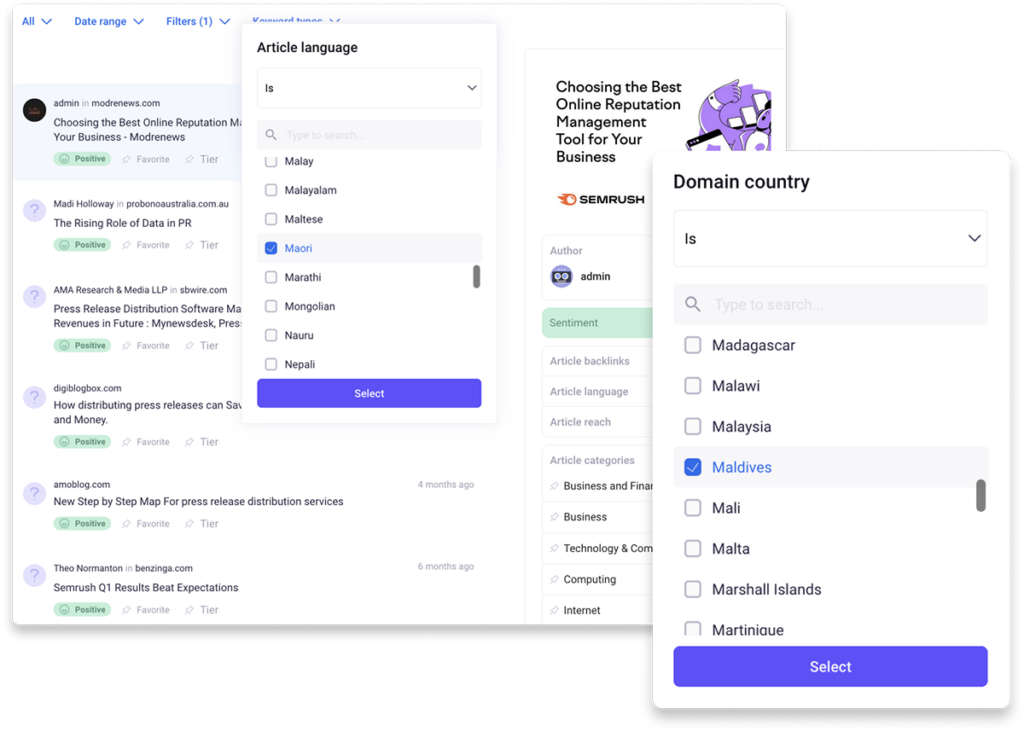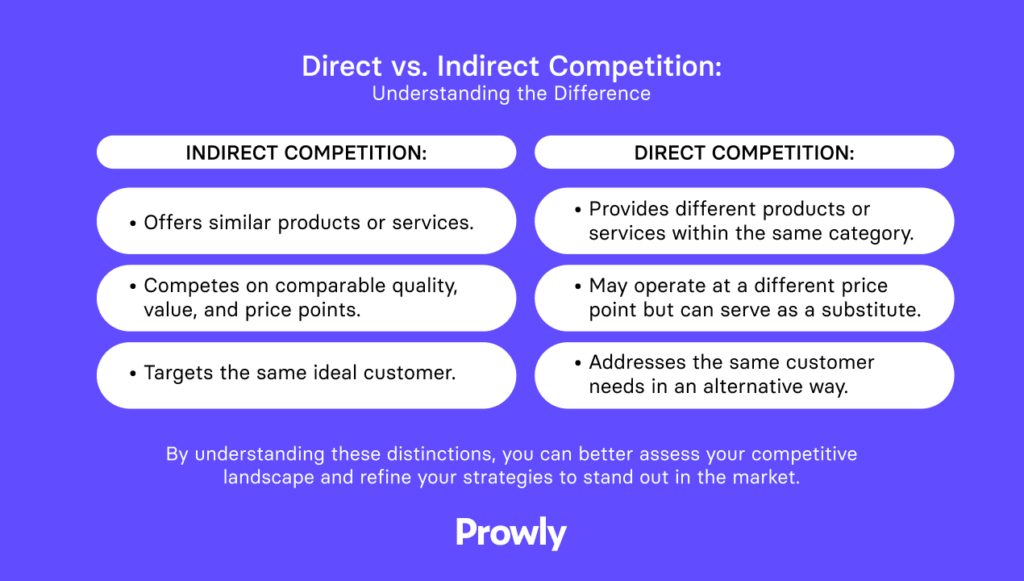Gianni Versace famously said: "It is nice to have valid competition; it pushes you to do better."
Indeed, competition in any industry can motivate you to build better products, more innovative campaigns, and make your customers happier. And monitoring competitors is a necessity to do just that.
Today, we'll show you how to track your competitors, what to pay attention to, which metrics to pick, and more. Whether you're in marketing or PR, you'll get the definitive guide on competitive monitoring.
| Luckily, competitor tracking in 2025 is much easier than in the 80s–if you know what tools to use (and how to use them). Prowly is one such tool, offering a 7-day free trial so you can experience it for yourself. |
What is competitive monitoring?
In marketing and PR, competitive monitoring is tracking and analyzing competitor activities, strategies, and market positioning. It covers several areas, such as social media, websites, content and campaigns, product launches, reviews, and more.
The most significant benefits of competitive monitoring include:
- Finding new market opportunities by spotting gaps in competitors' offerings
- Improving the positioning of your company or brand by refining your messaging based on the competition's strengths and weaknesses
- Driving innovative product development by gathering the most relevant competitive insights and finding out what problems your competitors are not solving for your target audience
- Setting benchmarks and KPIs by comparing your own against your competitors' strategies to determine what performs well and what doesn't
How do you track competitors and market trends?
👉 Share of Voice is just the beginning
While it’s an important quantitative metric, it’s only the surface. Dive deeper with properly configured queries and keyword setups to uncover more meaningful insights.
👉 The real value lies beyond tracking competitor mentions
It’s about understanding their narrative strategy. Which messages and keywords are gaining traction in top media? What themes or niche audiences are they neglecting? These insights can guide your unique positioning and help you carve out a distinct space in the media landscape.
👉 Enhance your pitching strategy
Identify the top media outlets and journalists covering your industry trends and competitors. Understand their focus areas to tailor compelling story angles that resonate with them.
With tools like Prowly, you can do your competitive tracking faster and cheaper than ever, making competitive analysis and monitoring necessary for any brand in 2025.
Key competitive monitoring areas
"I struggle with getting coverage, although I see our competitors in the media a lot." Does it sound familiar?
With the right media monitoring tools you can:
- Analyze which media outlets frequently mention your competitors and how they do it
- Identify the competitor messages that resonate most with journalists
- Map journalists' preferred story angles based on their keyword patterns
- Identify narrative gaps your brand could own
- Spot trending topics early to pitch timely stories
So instead, you’ll be thinking: "Our PR reports are interesting for the C-suite—they get the value we bring!"
Tracking competitor performance in 2025 boils down to a group of key channels, regardless of your industry.
Here is what you should pay special attention to:
Social media monitoring
In 2024, Facebook has over 3 billion users while LinkedIn is just over the 800 million mark. Monitoring competitors must include their social media performance.
When it comes to their owned channels, you can simply hit the "follow" button on your preferred social media platform and see what kind of content all of your competitors put out.
You can do that even without competitor analysis tools. But that would be quite obvious – and we're not opting for obvious in advanced PR strategies.

The fun begins with social media monitoring tools, such as Prowly, which allow you to track specific keywords, campaigns, and brand names. For example, you can track "Pepsi" as a brand name and get a notification whenever someone mentions it on any social media platform.
Social media monitoring in 2025 is highly evolved and comes with features such as:
- Detailed filters (for different platforms, languages, countries, regions, etc.)
- Sentiment analysis based on AI (automatically sorting mentions into buckets such as negative, positive, and neutral)
- Mention notifications with summaries
- Detailed analytics
- Key metric tracking (AVE, mention sentiment, outlet reach, domain backlinks, engagement)
- Reporting through custom dashboards
- Identification of spikes which can indicate social media crises
- And much more

Set up your social media monitoring platform once and watch your competitors' mentions roll in in real time.
Print and broadcast monitoring
Traditional media are not dead. In fact, some traditional outlets are regarded as more prestigious than their digital counterparts.
Consider the difference between a mention on Vogue's website versus being featured in its iconic print magazine. The impact is significant—not only in terms of quality perception, but also in content longevity.
👉 Online articles have shorter lifespans, are often skimmed, and capture less attention.
👉 In contrast, traditional magazines hold our focus longer and are more memorable.
With comprehensive print monitoring and broadcast monitoring you:
- Gain complete coverage across all media types, including online, social platforms, print, and broadcast.
- Centralize your monitoring and reporting in one easy-to-use platform.
- Overcome localization challenges with tailored regional packages that allow you to track media coverage across different countries and regions seamlessly.

By integrating traditional media monitoring into your strategy, you ensure no opportunity for impactful coverage is missed. Prowly will do it all for you.
Website traffic and SEO
To effectively track your competitor, you need to know what they're doing on and off their website. Luckily, many SEO tools can reveal what kind of SEO campaigns your competitors are working on and the results they bring.
Some of the things you want to track your competitors for include:
- Their organic traffic
- Their domain authority score
- The keywords they are ranking for
- The pages that they are building links to and want to promote
- The fluctuations in their organic traffic over time
- The pages that they bid for in paid search
Some of the best tools for this kind of work are:
👉 Semrush
👉 Ahrefs
👉 Moz
👉 SERanking
For content and SEO-focused tasks, choose Semrush or a similar tool.
For PR purposes and effortless competitor monitoring, you can simply get Prowly. In addition to social media monitoring, it also comes with traffic insights and audience analytics from Semrush.

Content and campaign analysis
Media Monitoring queries are not only for your brand’s coverage tracking. And dashboards are much more than just your recent campaign metrics.
In addition to their mentions and website performance, you want to monitor your competitors' messaging and media campaigns and determine their key metrics, such as engagement and mentions.
For example, if you wanted to track the performance of a campaign such as #shareacoke, you could simply load that term into Prowly's media monitoring tool.

You'd get statistics on:
- The number of mentions
- The number of retweets
- The sentiment behind those mentions
- The engagement and reach of the campaign
Additionally, you can edit queries and use keywords as filters—both in dashboards and email alerts. This allows you to shift from a broad stream of mentions to precise, actionable intelligence:
👉 Focus on the most impactful conversations
👉 Enhance flexibility in analysis
👉 Make faster, more confident decisions
And all of this in one tool.
Ready to monitor competitors?
How to monitor competitors in three steps
Theory is nice, but let's explore the practical aspects of monitoring your competitors:
#1 Identify competitors
To start competitor monitoring, you need to list your direct competitors.
These are businesses offering a similar product or service and targeting the same target audience as you. For example, if you're selling potato chips, Lays and Pringles would be your direct competitors.
Then, list out your indirect competitors.
These are companies that solve your customers' pain points but in a different way. In the case of potato chips, your indirect competitor would be Cheetos - a popular brand your customers might love but which does not offer the same product category as your business.

#2 Determine what you should monitor
Depending on your goals and the type of campaigns you run, you're going to monitor competition through different metrics and platforms.
For example, if you're measuring brand coverage, you may be interested in direct brand mentions only. If you're focusing on PR campaigns, you'll measure media placements online and offline. If you launched a social media campaign simultaneously as a competitor, you'll measure social engagement.
#3 Select the right competition monitoring tools
Depending on the type of competitors you want to track and the metrics you want to cover, you'll choose the tool that meets the largest number of your needs.
Or you can choose Prowly, which covers all of your social media and competitor monitoring needs in one place.

With Prowly, you can:
- Track brand and keyword mentions in real-time
- Get sentiment analysis for each mention
- Get detailed reports for each of your competitors
- Break down results based on channels, languages, countries and much more.
The most important metrics to track when doing competitor analysis
The metrics for competitor monitoring will differ based on who your competitors are, which industry you're in, and what kind of results you want to achieve.
However, these are some of the most important KPIs to keep track of.
- Mentions and sentiment: the number of mentions your competitors get and the sentiment behind them. In other words, whether their perception is positive, neutral or negative. AI-backed tools, such as Prowly, can help with this.
- Traffic and rankings: how much organic traffic your competitors are grabbing and what the source is. In other words, which pages and keywords they are ranking for.
- Social engagement: their overall performance on social media, including metrics such as social shares, post comments, and the influence of their PR campaigns.
Strategic value of competitor monitoring
Competitor monitoring is not just nice to have. It's one of the easiest ways to stay in the loop and make more informed decisions about your digital PR strategy. Besides being in the know, monitoring your competitors has certain strategic upsides.
Informed decision-making
You'll learn about competitors' campaigns, their new features and product releases, pricing changes, new market positioning, and more. All of this can help shape your future marketing and PR campaigns.
Market trends and benchmarking
Monitoring regularly helps reveal trends and set benchmarks for your own marketing and PR campaigns.
Identifying opportunities and threats
You can easily spot gaps and evaluate where you could take a slice of the market. Additionally, you learn which competitors could potentially harm you by taking some of your target audience for themselves.
Customer retention and acquisition
By listening to what competitors' customers say, you can stay in touch with your customer base and identify their needs and aspirations. In the long run, this prevents churn and increases customer satisfaction.
Start monitoring your competitors with Prowly
Prowly is a PR and media relations tool built for public relations and marketing teams. It has a rich media database, multiple tools for creating press releases, and competitive monitoring features.
Our social media monitoring tools let you set up specific filters for tracking competitors online and offline. Whether on social media, websites, blogs, broadcasts or forums, you'll know who talks about your competitors and when.
Offline mentions are no problem. Prowly tracks print and broadcast mentions, letting you stay on top of all your competitors' activities in one dashboard.

